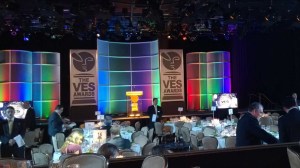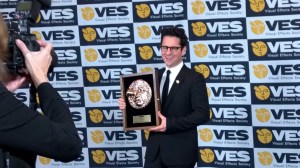 The truth is you no longer need Below the Line, or any trade publication in particular, to tell you who won at the VES Awards last night. You’ve already seen tweets, emails and live blogs as it was happening, or perhaps you were there.
The truth is you no longer need Below the Line, or any trade publication in particular, to tell you who won at the VES Awards last night. You’ve already seen tweets, emails and live blogs as it was happening, or perhaps you were there.
So you probably already know that Big Hero 6 and the latest Planet of the Apes did surprisingly well. Does this indicate an upset in the best animated film and best visual effects categories on Oscar night? Will the latest How to Train Your Dragon, or Christopher Nolan’s Interstellar be left behind if VES serves as an augury in how Tinsel Town is assessing the worthiness VFX?
Well, there’s still a lot of February ahead of us, but perhaps, in the same way that the SAG Awards signaled that all might be not be quite settled in the best acting or picture categories, the VES Awards has tipped us that the odds are not what we thought they were.
But as with all awards shows in Hollywood, the truth of the evening – the subtext – begins at the bar, or wherever it is that the anointed group gathers before the awards themselves begin to unspool.
So it was that Below the Line started the evening at the Beverly Hilton’s bar, ahead of dinner/drink/reception for check-in, only to overhear a member of the VES Board state that “an enormous amount of visual effects are done somewhere. They just don’t seem to be done around here, anymore.”
As it turned out, this Proustian “Remembrance Of Things Past” would become a motif of the evening, as much as the praises that were sung for what lay ahead.

Nonetheless: “Wait till you see that sunshine place / Ain’t nothin’ like it here”
But, of course, if that “sunshine place” means Hollywood, it would appear there are things like it, somewhere, because that’s where most of the rendering is happening. And as VES head Eric Roth even opined to our colleagues over at Variety, it was no longer a sure thing that the VES Awards itself would always be held in L.A. They might wind up in London, Vancouver or some other center of visual effects.
We’ve only tasted the wine / We’re gonna drain the cup dry
But who’s cup gets drained? With whose tax incentives or production credits?
As those questions lingered, our dinner seating provided both full cups, and positioning between two additional VES board members. Each of whom talked about the radical changes still afoot in the industry. One opined that that VFX work had gone the way of all manufacturing work in America, like textiles, electronics, etc. It had, inevitably, been off-shored. He wasn’t sure if there was a solution to this, other than offering that young folks seeking a career in visual effects needed to keep their passports handy, honed and ready to roll.
His analysis of how the industry had changed was that when there were fewer houses, they could do easy shots, and perhaps pad what they charged for them, while taking a loss on harder shots – which meant, essentially creatures requiring flesh, hair, musculature, etc. — and the numbers, in the end, could work out, if it was all a single budget.
Now, in this world of piece work, the easy shots are farmed out to easier economies, and the hard shots, still perhaps rendered in the one or two stateside shops entrusted to tentpoles, are routinely underbid.
How long can such an economic model hold?
The first board member’s slightly younger counterpart agreed with this contention. But he opined that for those wishing to stay in Hollywood, TV work was now where it was at. With a couple hundred or more FX shots desired per superhero episode, this rivaled what had been considered a maximum for feature film as recently as the ’90s.
As audience expectations become indivisible between what they see in the Cineplex, and what they see on their smaller HD living room screens – with stories increasingly set in the very same universes as those holiday and summer tentpoles – delivering north of 100, 200 or even 300 FX shots for such episodes is no longer newsworthy, but business as usual.
Meanwhile, as Big Hero 6 and Dawn of the Planet of the Apes continued to rack up their awards (with some love shown for the Pentagon kitchen sequence in X-Men: Days of Future Past), JJ Abrams was given the Visionary Award, not only for the visions he’s already had, but for those to come, being at the directorial juncture of every great space-themed franchise launched, and nurtured, by assorted studios, not to mention his work on such television series as Lost and Fringe.
Abrams was gracious on the dais, acknowledging the “ridiculous fun” he was having, realizing the various childhood dreams that seemed legitimized, or at least nurtured, when his father brought home an autograph from no less than Douglas Trumbull, and then thanked his parents again, who let him “blow shit up, and film it.”
It was then time to recess from the banquet hall to the press room, to have a few words with Abrams himself.
He remained gracious, and clearly gratified, to be able to blow up shit in so many brand name movies. We asked him whether it was the advent of visual effects – so necessary in terms of box office hits – that allowed him to pursue the kind of storytelling he clearly excelled at.
He said that he wasn’t married to effects, per se. The costs were often not different between rendering something, and doing it practically, and his notion was to do whatever served the story best, while allowing those actors to remain in that story, whenever possible.
Abrams was also asked if the expansion of his Bad Robot production house meant that the VFX work for his films would, increasingly, be done here, but he remained noncommittal on that front, while again averring that what mattered was the right effect for the story, whether practical, or not.
In a sense, he was coming full circle to how the evening’s host, Patton Oswalt, opened by joking about his own position as Award Show host. “What are they gon’na do?” he said. “Fire me? Oh no! There goes my annual basket of muffins.”
Perhaps, then, that was the real tension in the room. Not what or who would win, but where all that daily bread – or those daily muffins – would come from.
And, per the song in the Hilton lobby, “Wait till you see that sunshine place/ Ain’t nothin’ like it here,” those muffin baskets, and the postproduction work, will come from someplace entirely different than Hollywood.
Wherever that is, VES will evidently be there to celebrate. Meanwhile, all hail Ceasar, Baymax and the X-Men, wherever they may be rendered.
The winners of the 13th Annual VES Awards are:
Outstanding Visual Effects in a Visual Effects-Driven Photoreal/Live Action Feature Motion Picture
Dawn of the Planet of the Apes
Joe Letteri
Ryan Stafford
Matt Kutcher
Dan Lemmon
Hannah Bianchini
Outstanding Supporting Visual Effects in a Photoreal/Live Action Feature Motion Picture
Birdman
Ara Khanikian
Ivy Agregan
Jake Braver
Isabelle Langlois
Outstanding Animation in an Animated Feature Motion Picture
Big Hero 6
Don Hall
Chris Williams
Roy Conli
Zach Parrish
Outstanding Visual Effects in a Visual Effects-Driven Photoreal/Live Action Broadcast Program
Game of Thrones; The Children
Joe Bauer
Steve Kullback
Stuart Brisdon
Thomas Schelesny
Sven Martin
Outstanding Supporting Visual Effects in a Visual Effects-Driven Photoreal/Live Action Broadcast Program
American Horror Story; Freak Show; Edward Mordrake, Part 2
Jason Piccioni
Jason Spratt
Mike Kirylo
Justin Ball
Eric Roberts
Outstanding Real-Time Visuals in a Video Game
Call of Duty: Advanced Warfare
Yi-chao Sandy Lin-Chiang
Joseph Salud
Demetrius Leal
Dave Blizard
Outstanding Visual Effects in a Commercial
SSE, “Maya”
Neil Davies
Alex Hammond
Jorge Montiel
Beth Vander
Outstanding Visual Effects in a Special Venue Project
Ratatouille: L’Aventure Totalement Toquee de Remy
Tony Apodaca
Marianne McLean
Gilles Martin
Edwin Chang
Mark Mine
Outstanding Performance of an Animated Character in a Photoreal/Live Action Feature Motion Picture
Dawn of the Planet of the Apes – Caesar
Paul Story
Eteuati Tema
Andrea Merlo
Emiliano Padovani
Outstanding Performance of an Animated Character in an Animated Feature Motion Picture
Big Hero 6 – Baymax
Colin Eckart
John Kahwaty
Zach Parrish
Zack Petroc
Outstanding Performance of an Animated Character in a Commercial, Broadcast Program, or Video Game
SSE, “Maya”
Jorge Montiel
Alex Hammond
Daniel Kmet
Philippe Moine
Outstanding Created Environment in a Photoreal/Live Action Feature Motion Picture
Interstellar – Tesseract
Tom Bracht
Graham Page
Thomas Døhlen
Kirsty Clark
Outstanding Created Environment in an Animated Feature Motion Picture
Big Hero 6 – Into the Portal
Ralf Habel
David Hutchins
Michael Kaschalk
Olun Riley
Outstanding Created Environment in a Commercial, Broadcast Program, or Video Game
Game of Thrones – Braavos Establisher
Rene Borst
Christian Zilliken
Jan Burda
Steffen Metzner
Outstanding Virtual Cinematography in a Photoreal/Live Action Motion Media Project
X-Men: Days of Future Past – Kitchen Scene
Austin Bonang
Casey Schatz
Dennis Jones
Newton Thomas Sigel
Outstanding Models in any Motion Media Project
Big Hero 6 – City of San Fransokyo
Brett Achorn
Minh Duong
Scott Watanabe
Larry Wu
Outstanding Effects Simulations in a Photoreal/Live Action Feature Motion Picture
X-Men: Days of Future Past – Quicksilver Pentagon Kitchen
Adam Paschke
Premamurti Paetsch
Sam Hancock
Timmy Lundin
Outstanding Effects Simulations in an Animated Feature Motion Picture
Big Hero 6
Henrik Falt
David Hutchins
Michael Kaschalk
John Kosnik
Outstanding Effects Simulations in a Commercial, Broadcast Program, or Video Game
Cosmos: A Spacetime Odyssey
Dominique Vidal
Isabelle Perin-Leduc
Sandrine Lurde
Alexandre Lerouge
Outstanding Compositing in a Photoreal/Live Action Feature Motion Picture
Dawn of the Planet of the Apes
Christoph Salzmann
Florian Schroeder
Quentin Hema
Simone Riginelli
Outstanding Compositing in a Photoreal/Live Action Broadcast Program
Game of Thrones – The Watchers on the Wall
Dan Breckwoldt
Martin Furman
Sophie Marfleet
Eric Andrusyszyn
Outstanding Compositing in a in a Photoreal/Live Action Commercial
SSE
Neil Davies
Leonardo Costa
Gianluca DiMarco
Outstanding Visual Effects in a Student Project
Wrapped
Roman Kaelin
Falko Paeper
Florian Wittmann
Paolo Tamburrino





